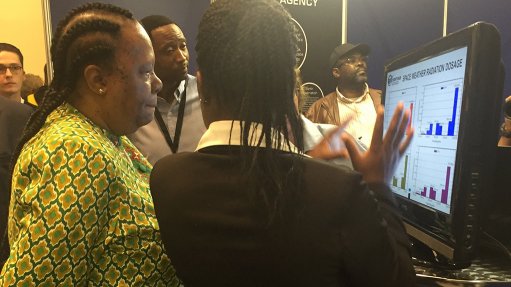
Science & Technolgoy Minister Naledi Pandor on a tour of the various exhibitors that the department funds
Advances in the Square Kilometre Array (SKA) programme, a significant fluorochemical expansion initiative and a R30-million science centre in Cofimvaba, in the Eastern Cape, were highlighted during the yearly Science and Technology budget vote debate in Parliament on Tuesday.
Science and Technology Minister Naledi Pandor told the National Assembly that the first 16 MeerKAT antennae would be ready by June 30, with the 21 antennae in place being “fewer than planned, but enough to allow scientists to begin work”.
Pandor said over R1-billion would be invested in the construction of MeerKAT and in overall SKA project costs in 2016.
“The department is positioning South Africa and the continent as a hub of research excellence with world-class facilities for multi-wavelength astronomy,” the Minister said, adding that a strategy on multi-wavelength astronomy would be finalised this year, consolidating optical, radio and gamma ray astronomy facilities under a single astronomy sub-agency in the National Research Foundation.
Pandor was particularly pleased with the SKA human capital programme, aimed at developing a new generation of young researchers and engineers. The initiative, which started with an intake of nine students 11 years ago, has supported 730 students and researchers, from undergraduate to postdoctoral level.
Further, the Department of Science & Technology (DST) continued to invest in the fluorochemical expansion initiative through Pelchem, together with the R45-million the DST announced it would invest last year.
“Success will allow Pelchem to develop promising new technologies and fluorochemical products and to double its turnover to R400-million per annum by 2019,” said Pandor.
She added that the department’s strategy to develop a disruptive and novel technology to produce titanium metal powder continued. “We have redesigned the pilot plant to restart test runs from October 2016.”
A large slice of the DST’s budget – R4.2-billion – has been allocated to the department’s Research Development and Support branch.
Pandor said the department was the largest funder of postgraduate students in South Africa and was investing R741-million in 2016 to support 14 500 postgraduate students, 67% of whom were black, and 57% female. The department exceeded its target to appoint more women as South African Research Chairs Initiative (SARCHi) chairs, with women now making up 39% of SARCHi chairs.
Meanwhile, the planned R30-million Science Centre in Cofimvaba, will be opened during youth month in June.
R27-million will be allocated to implement the National Integrated Cyber Infrastructure System. Pandor said a significant amount would be invested in big data, moving South Africa further on its path to becoming a knowledge economy.
“It is estimated that between 23 000 to 31 000 specialists with deep analytics and big data skills will be needed by 2018,” she told the National Assembly.
The department would also support the Centre for High Performance Computing, which had just installed its new supercomputer to provide 1 000 teraflops (one petaflop) of computing power to researchers. The facility was upgraded to meet the growing demand for use by university and industrial researchers.
The DST also allocated R33-million in the current financial year to support 32 manufacturing companies that are linked to major localisation projects through the government’s Technology Localisation Programme.
Pandor said the department would also finalise a full impact assessment of the programme, noting that 20 firms that had been given R25-million of government support had secured more than R162-million in contracts.